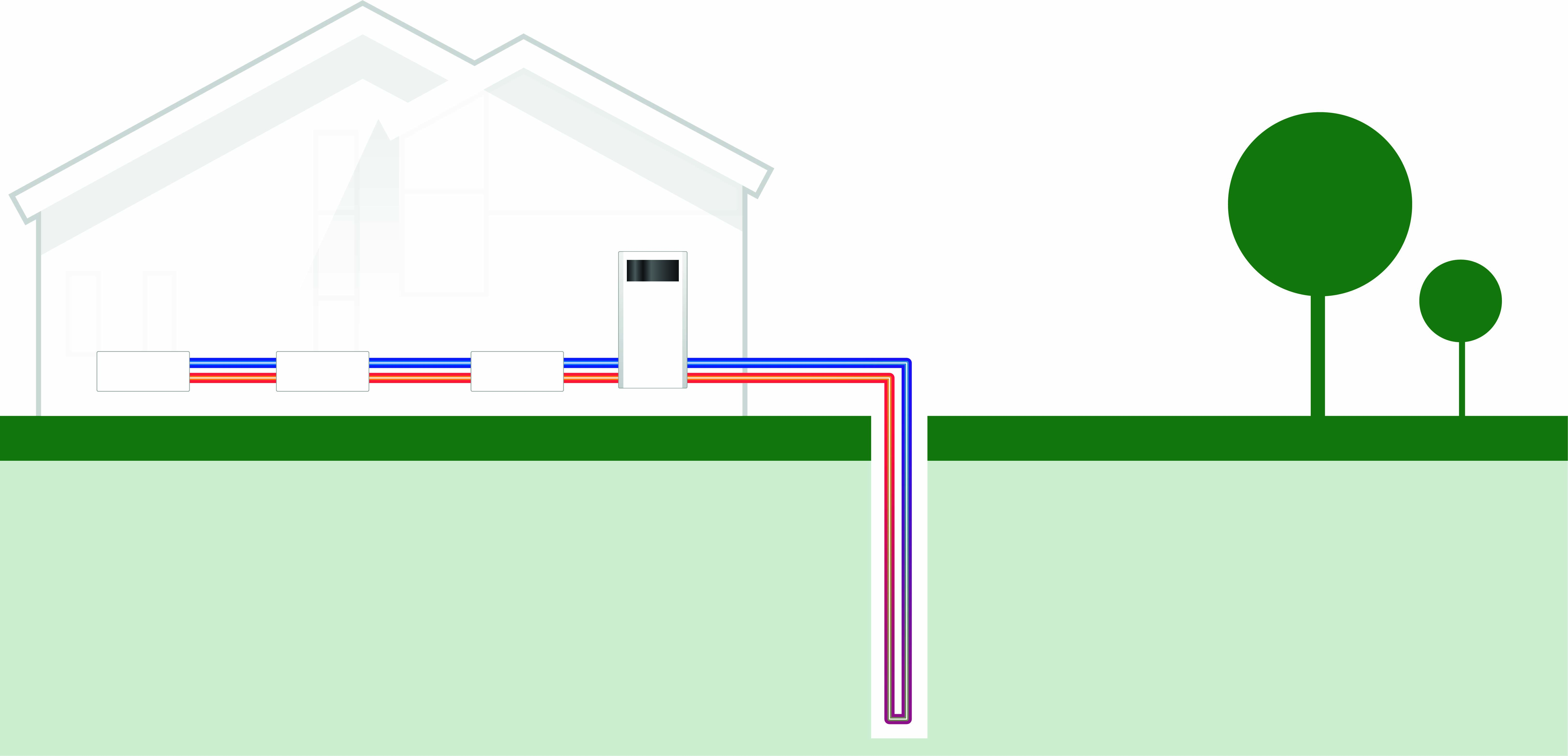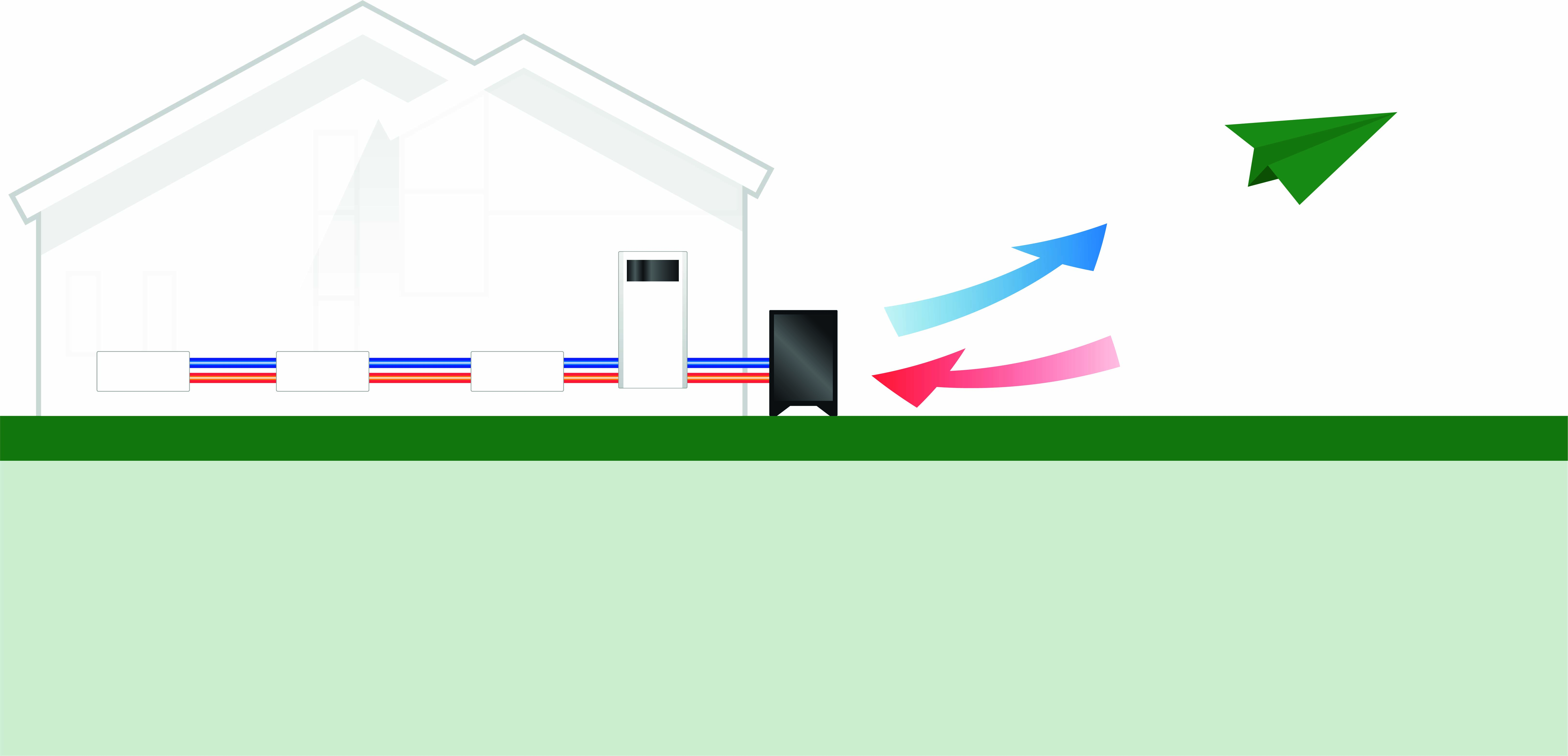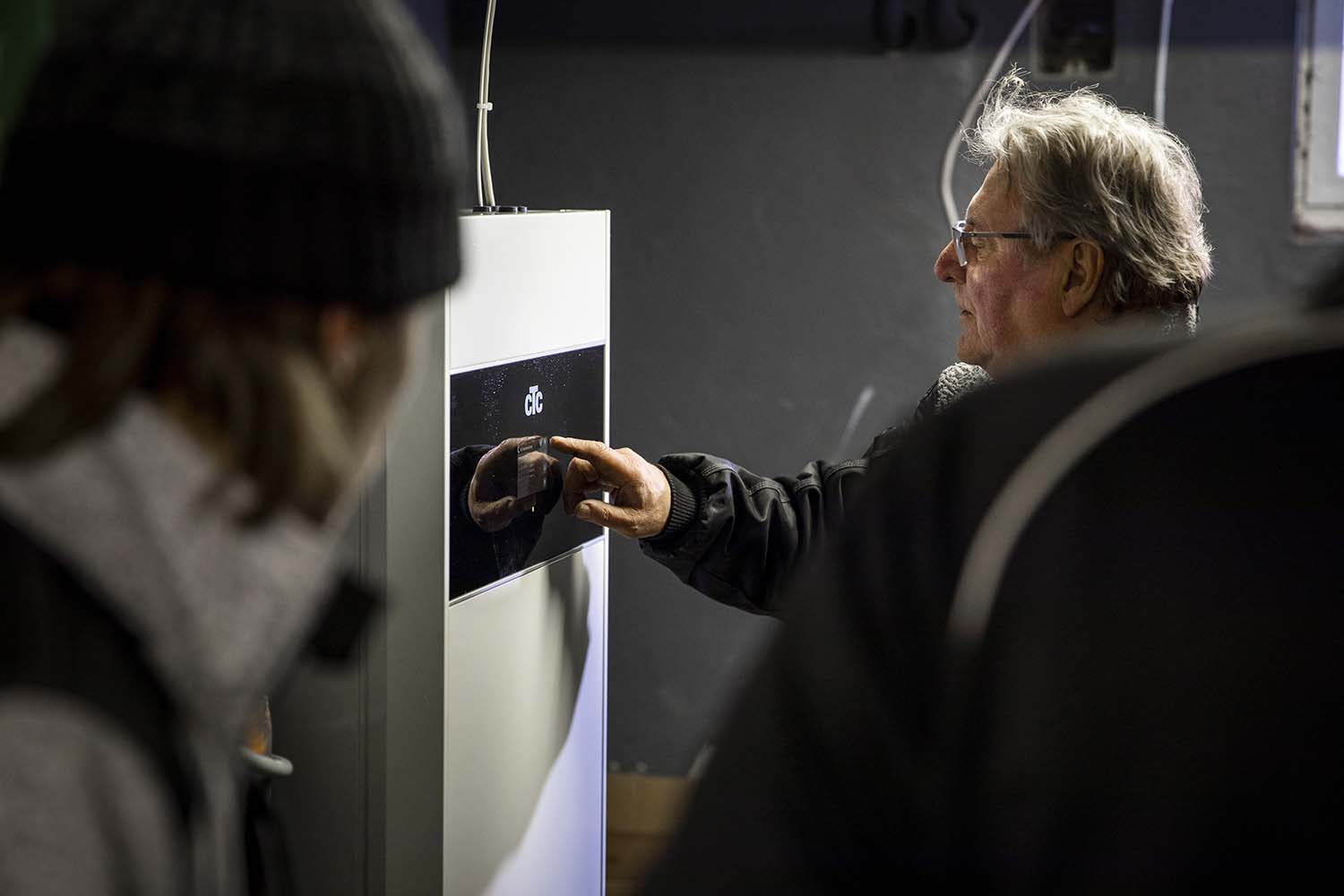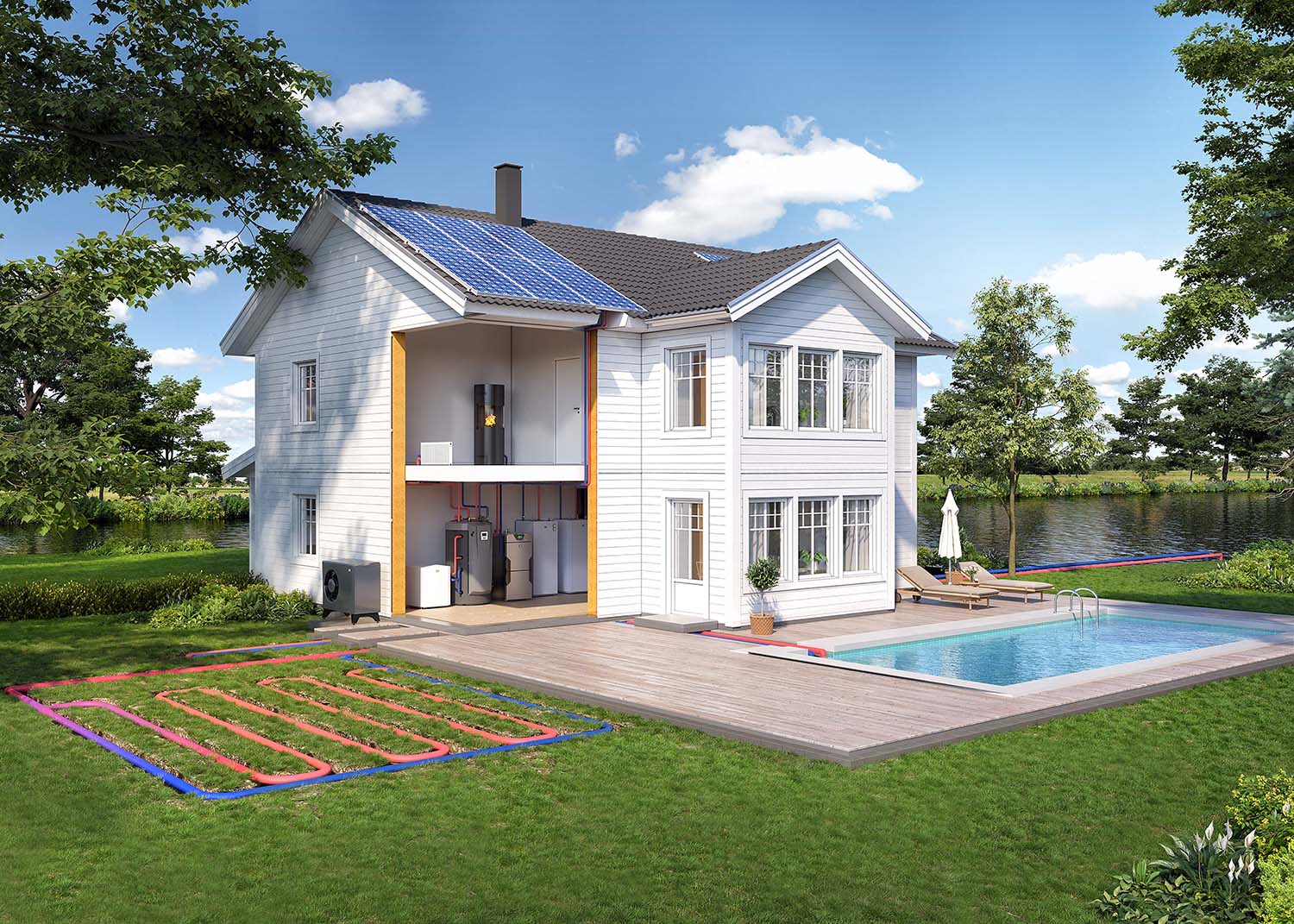
Starting guide to the good life with a heat pump
This is CTC
CTC works actively for a sustainable and fossil-free society. We build the heat pumps in Ljungby, Sweden and our roots go back to 1923 when we started heating Swedish homes.
With the Heat Pump Guide, you get a handle on this with heating systems and heat pumps. We have collected our best tips - so that you can also be part of the solution to the challenges of the future. Heat pumps make a difference - both for you and the climate.

How can you best heat your house or property?
 (1).jpg)
Heat pumps make a difference - both for you and the climate
In this guide, we'll look at the difference between having a heat pump compared to, for example, district heating, a wood boiler or direct electricity. You'll learn about the different heating systems and be able to decide what's right for you. We'll guide you through the whole buying process and installation. After reading, you'll know what to think when you meet the dealer and when you get a quote.
What is good about a heat pump?
If you have ground source heating, you can't just heat your house. You can cool your bedroom or cool the room that's bathed in sunshine. You can supplement your heating system with just about anything you can find in the way of heat and become self-sufficient in heating, hot water and cooling. If you choose to add solar cells, you'll also be self-sufficient in electricity. Locally produced is good, we think.
Free and renewable energy
The heat pump works with renewable energy sources that are completely free. Think about it: energy is abundant all around us. There's no shortage of energy, just a shortage of ways to capture and convert it. A heat pump is a great way to capture and convert energy from the ground, water and air.
Saves money
With a heat pump, you not only save the environment but also your heating costs. With a heat pump, you can save up to 85 % on heating and hot water. It draws little electricity for its own operation but gives much more energy back.
Large buildings
If you own a large property, you can get the solution that suits you best, including advice and support. A CTC heat pump can work with up to ten other units, which is unique in the industry.
.jpg)
Compare heat pump with other heat sources
.jpg)
Some things that matter when choosing a heating system are how large an area will be heated, how much hot water will be consumed, what heating system the house currently has, where in the country you live and what the surroundings look like.
Waterborne, electric or airborne?
- Waterborne heating in radiators or underfloor coils. This is the most common and usually the most energy-efficient way to heat houses. The water is heated by a heat pump, district heating, boiler firing or electricity.
- Electric heating via radiators or underfloor heating. Connected directly to the electricity grid.
- Airborne heating system. Requires no radiators to distribute heat but good air circulation is important in all rooms. Indoor or outdoor air is heated by different techniques.
Heat pumps
A CTC heat pump collects renewable energy from outdoor air, ground or water and saves up to 85 % of your energy costs. You get even and comfortable heat all year round. The only requirement is that the house must have hydronic heating. For every kWh of electricity the heat pump draws, it gives back 4-5 kWh.
Another advantage of CTC heat pumps is that you can create a system of up to ten different heat and electricity sources for your house. For example, you can connect the heat pump to a water-coated wood stove or wood boiler as a backup. You can also heat the pool or cool a room. If you have solar cells, you will in principle be self-sufficient in electricity and heat for much of the year.
Pellet or wood boiler
Pellets and wood are cheaper than electricity and district heating, but you need to do your own work to charge the boiler. Of course, if you have free wood, you also get free heat, but this is also labour-intensive. Burning pellets or wood also means that you emit some air pollutants that can be dangerous to your health and the environment.
District heating
The price of district heating is usually lower than for electricity, but it varies depending on where you live. District heating is cheapest in densely populated areas where networks have been built up over a long period of time and production costs can be kept low. District heating is large-scale. Water is heated in a central plant and pumped out under high pressure to each home or property. The energy comes from biofuels - combustible waste or logging residues.
Electric heating
Electricity is the most expensive source of heating, and bills are particularly high in winter. Electricity prices can also vary widely throughout the year and it can be difficult to control costs. One advantage is that there is no investment required other than electric elements or heating coils.
Air source heating
The most common is the air-to-air heat pump, which converts energy from the outside air. The system needs to be complemented by a water heater as an air-to-air heat pump does not heat water. The heat pump is installed in a strategic location in the home. Circulation must be good in all rooms to distribute the heat optimally. It is often necessary to add electric elements in the rooms furthest away from the heat pump. Another option is an exhaust air heat pump that works in conjunction with waterborne heating. The pump recovers heat from indoor air and also heats hot water. The house must have proper ventilation ducts and valves for fresh air intake, otherwise this solution is not suitable.
Heat pump is better for the climate
.jpg)
Heat pumps have reduced the need for purchased electricity for hundreds of thousands of Swedish households. It draws little electricity of its own but gives back several times more energy.
A heat pump can extract energy in several ways. Energy exists and is stored all around us. In rock, water, air and the earth's surface. It all starts with the sun. The sun is the basis for using a heat pump to harness energy and convert it into heat. It's almost magical - but even in the middle of a cold winter, a heat pump extracts the energy and delivers heat.
Ground source heating

Ground source heat pumps
- Suitable for small plots
- Low impact on the site
- High efficiency
- Comfort cooling
Heating your home with ground source heateing heat can result in savings of up to 85 %. Installation requires drilling holes in the bedrock. A ground source system draws its energy from solar energy, which is passively stored in soil, rock and groundwater. Groundwater can often be found at a depth of ten meters, but to get energy for an entire house requires much deeper boreholes than that, usually 90 to 200 meters.
The borehole, which is about 15 cm in diameter, is fitted with a collector tube that acts as a heat exchanger. A coolant (brine fluid), usually a mixture of bioethanol and water, circulates in the collector tube.
The ground source heat pump is the heart of the system, ensuring that the brine circulates. Already at four degrees, the temperature is sufficient for a heat-sensitive refrigerant inside the pump to boil and evaporate.
The steam generated by the vaporization of the refrigerant is then compressed by a compressor. The heat generated is transferred to the water circulating in the elements and to the water used for showering, washing dishes and laundry.
With a ground source heat pump, you can save up to 85 % of energy consumption for heating and hot water. A ground source heat pump has very low operating costs, which means that the investment usually pays for itself within a few years.
Permits are usually required to install a heat pump. Check with your representative what applies in your area.
 (1).jpg)
The ground source heat pump is the heart of the system

Air-to-water heat pumps
- Low installation cost
- No drilling
- High efficiency
- No impact on lawn and garden
Air-to-water heat pumps transfer the energy of the air into heat and hot water. Since an air-to-water heat pump does not require boreholes or ground loops, it is easy to install.
The energy used is free, environmentally friendly and helps to reduce greenhouse gas emissions. With a CTC air-to-water heat pump, you can save up to 75 % of your heating costs.
An air-to-water heat pump has very low operating costs, so the investment usually pays for itself within a few years.
Air-to-water heat pumps work even if the temperature drops to -20 °C.
The heat pump's outdoor unit is placed outside the house, close to the wall. The pump contains a heat-sensitive refrigerant that boils and evaporates.
A permit is usually required to install a heat pump. Check with your representative what applies in your country.
Air-to-water heat pumps work even if the temperature drops to -20 °C.
How does a heat pump work?
A heat pump extracts its energy from the ground, air or water, whether it's summer and hot or winter and cold. But how does it actually work?
The technology is based on your heat pump taking energy from the environment and feeding it into your system. Your system circulates a refrigerant that has a very low boiling point. The system is always colder than the environment, even at very low temperatures.
This small temperature difference is what makes the technology work. The refrigerant collects energy and starts to boil, eventually evaporating. The steam is fed into the compressor where the air is compressed, raising the temperature significantly.
The same effect that makes a bicycle pump hot when you pump a tyre. When the steam is hot enough, it is released into the heat pump system and heats the surrounding water, which you then use to heat the house or the water in the shower.
Once the refrigerant has given off its heat, it needs to be cooled down so that the process can start again.
Example of the process in a heat pump:
- A fluid circulates in a collector hose. The liquid absorbs heat from rock, soil, air or water.
- Through a heat exchanger, also called an evaporator, the liquid meets the refrigerant, which evaporates.
- The compressor increases the pressure on the refrigerant, thus raising the temperature.
- A heat exchanger (condenser) transfers the heat to the property.
- The pressure of the refrigerant cools down and the process starts again.
Tips for a successful heat pump purchase

Have you decided to buy and install a heat pump? Here are some valuable tips before you contact a dealer.
1. Things to consider when choosing a dealer
The dealer is your most important contact before, during and after installation. A good dealer is responsible for the entire installation. It all starts with finding out your energy needs by creating a unique energy calculation for your property.
Once that's done, together you'll choose an installation that's right-sized for your property. Finally, make sure you get a clear quote that includes everything. At CTC, we are in daily contact with our CTC partners (dealers) and local HVAC installers. Our job is to support them in their calculations so that you are satisfied with your installation.
Some plumbers choose to specialise in heat pump installations because it takes both knowledge and experience to make an accurate energy calculation and a good installation. It is important to use a reputable contractor to ensure that you get a heating system that delivers maximum efficiency at the best possible price. You can find our CTC partners and other HVAC installers at ctc.se/customerservice.
2. Make sure you get an accurate energy calculation
The dealer will make an energy calculation, which is calculated using a special program. The calculation takes into account the estimated annual consumption and determines the most suitable heat pump and installation solution. It also describes the estimated drilling depth and length of the loops and shows how quickly the investment pays for itself.
3. The key concept: annual efficiency
The annual efficiency ratio shows how your system will perform once it is installed in your home. The aim is for your new heat pump to give you the most energy possible - at the lowest possible cost. There are also concepts that show the performance of an individual pump in a protected lab environment. They are called COP or SCOP.
Anyone who compares these values straightforwardly, without taking into account all the local factors, may be sizing the system wrong. In reality, the efficiency of the pump will vary according to the unique conditions in your home. Your dealer will help you calculate the annual efficiency.
4. Size your hot water correctly
How much hot water do you use? Hot water accounts for a small but very important part of the pump's total operating economy. The cost must be kept down and the water must be sufficient even if there are many baths and showers and it is minus 20°C cold outside.
New hot water should be able to heat up quickly. For example, if you have a large bathtub that consumes hot water, you may need to choose a heat pump that is adapted to it or even supplement with an extra water heater.
5. Checklist for comparing offers: keep track of this
The risk with a quote that looks "cheap and good" is that it doesn't include everything you need. Go through the quote carefully and use the checklist below.
The quote should include a clear energy calculation that is tailored to your unique circumstances. Don't get stuck on the installation cost, it's the total savings over time, as shown in the energy calculation, that is most important!
The offer should give a clear recommendation on which heat pump(s) are suitable. It should be clear exactly what is included, and not included, in the installation.
Checklist:
- How is energy efficiency calculated?
- Is a follow-up visit after one month included?
- Who is responsible for removing materials and restoring the garden?
- Are materials and time included to protect the garden and property?
- Is the removal of older boilers, pumps and elements included?
- Are all electrical installations included?
- Does it include the casting of a slab or other solid surface on which to place the air/water heat pump and does it include the connection of a condensate drain?
- How many metres of feed pipe are included and how much does extra feed pipe cost?
- What warranties and insurances are included in the price?
- Are you also replacing radiators?
- Are all parts specified and timed?
- Does it state the time frame for completion of the work?
- Is the root allowance deducted in the quote? (Do you have any room left in your tax return to have the deduction approved this year?)
- Does the dealer help you apply for permits and fill out all the paperwork so you can just sign?
6. How long will the installation take?
Normally it takes a couple of three days and often the electricity in the house doesn't need to be off for more than a few hours. Do you need to install anything extra. e.g. new radiators, it will take longer. Check with your dealer and ask for an estimate.
7. Guarantees and insurance included
Anything can happen - although we make every effort to ensure that you have a comfortable, affordable and completely trouble-free heat pump system throughout its lifetime. We want you to feel completely comfortable with your purchase and with CTC. Check with your representative about your situation.
Smart extra features for your heat pump

Remote control
With the myUplink app, you can monitor and control your system directly from your smartphone. For example, you can adjust the temperature or receive an alarm in case of a breakdown. You can download myUplink free of charge wherever apps are available.
With myUplink, you can also control your home when you are on holiday. Lower the temperature when you're away and raise it when you're on your way home.
CTC SmartControl
This function ensures that heating, hot water and ventilation are optimized.
The foundation of the system is the CTC SmartControl Gateway, a base unit that can control up to seven optional wireless accessories. The series includes several smart accessories: a wireless room sensor powered by solar cells and a multi-button that can control several different functions such as extra hot water.
There are also humidity and CO2 sensors that can control ventilation on demand. The humidity sensor automatically increases ventilation when humidity increases in the shower or washroom. The CO2 sensor reduces ventilation when no one is home and can increase ventilation when, for example, family members are visiting.
CTC SmartControl ensures that ventilation is always optimized for a constant, good air quality while keeping ventilation and consumption at the right level.
Heat up the pool
Pools are becoming more and more common in gardens. To make swimming comfortable, you need to heat the pool and that's no problem if you have a CTC heat pump installed.
With a small upgrade, you can easily maintain a Mediterranean temperature in your pool all season long. Since the need for heating decreases during summer time, your heat pump can distribute the energy and heat the pool at a significantly lower cost.
Free cooling in summer
Free cooling, or passive cooling as it is also called, is obtained by the geothermal heat pump pumping up cold from the bedrock during warmer periods. The excess heat is then returned to the borehole, which increases the effect in colder parts of the year.
By connecting a fan convector to your heat pump, the borehole is used for air conditioning in the warmer parts of the year. This provides very low investment and operating costs compared to a traditional air conditioner.
To make it easy to use free cooling, we have developed a handy accessory that we call CTC EcoComfort. The unit is completely pre-wired from the factory and easy to connect to the system. The cooling function is controlled entirely from your controlling product, where you can also set your own preferences for when and how you want the comfortable cooling to be spread in the house.
Heat pump - the heart of your large heating system

Connect and supplement your heating system with just about anything you can find in the way of heat. Future-proof with Energy Flex.
It is common to connect the heat pump with other devices and get a heating and energy system with many functions: solar panels - heating the pool - pellet boiler - fireplaces - wood boiler - indoor module
High-efficiency variable speed heat pumps make the CTC GSi 600 series and CTC EcoAir 600M series some of the best heat pumps in their class.
When you choose a heat pump from CTC, you not only get a Swedish-made quality pump, but also much more freedom to choose your heating source in the future thanks to the built-in EnergyFlex.
When you invest in a heat pump from CTC, you can rest assured that you are installing one of the most reliable and long-lasting heat pumps on the market. Development and production take place in our factory in Småland, Sweden, where quality and innovation go hand in hand.
When you choose a heat pump from CTC, you have the option of expanding your heating system in the future thanks to the built-in EnergyFlex.
 Ground source heat pumps
Ground source heat pumps
 Air-to-water heat pumps
Air-to-water heat pumps
 Indoor modules
Indoor modules
 Ventilation solutions
Ventilation solutions
 Control for CTC heat pumps
Control for CTC heat pumps
 Hot water heaters
Hot water heaters
 Accumulator tanks
Accumulator tanks
 Electric heating
Electric heating
 Accessories
Accessories
